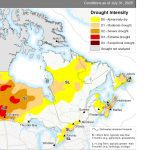RED DEER, Alta. – There may still be hope for producers who played the canola markets too long, according to an analyst who thinks prices will liven up in the next few months.
“All of the commodity markets are going to do what they call the ‘dead cat bounce’ and that’s going to be the start of a rally,” said Kris Olsen of AgPro to last week’s United Farmers of Alberta Grain Quality Congress here.
“This is an ugly time for grain prices. Don’t sell anything for the next four weeks. I think it will come back to life.”
Read Also

Alberta eases water access for riparian restoration
Alberta government removes requirement for temporary diversion licence to water plants up to 100 cubic metres per day for smaller riparian restoration projects
But although he thinks canola prices will increase 50 cents per bushel by June as carryout levels become tight, he warns farmers they won’t go back to pre-Christmas levels that were over $8 a bu.
After seeding, it will turn into a weather market where prices will rally and dip depending on drought scares, he said.
And if canola production increases by over 10 percent compared to last year it could mean trouble unless the Chinese and Japanese increase imports significantly, he said. Those Asian countries are wild cards right now and might give some hints at the end of August.
“The Chinese are the best card players in the business. They play us North Americans like a piano. If they don’t materialize it’s going to be nasty,” said Olsen, who estimates canola prices would then remain in the $7 or less range.
China imports
China, Canada’s second largest canola importer, took almost 1.2 million tonnes in the current crop year. Preliminary estimates show it will take 600,000 tonnes in 1999-2000, but Olsen thinks that figure is too conservative. In his opinion, imports will be equal to or higher than last year as Chinese oil consumption increases.
Meanwhile, he warns farmers to make sure grain is in a deliverable position once prices improve this spring.
“Don’t have any duck ponds in front of the bins. And position the grain in a place where you can slam an auger, put in a truck and get gone fast,” said Olsen, who notes producers absorbed in spring seeding often aren’t prepared for a fast sale.
Wheat prices at this time next year should be $10 to $15 per tonne better as worldwide consumption continues to outstrip production, said Olsen. He thinks production this year will increase slightly from last year.
He tells producers not to have a heart attack when they see the Canadian Wheat Board’s 1999-2000 pool return outlook due March 1.
“They will be lower but the movement is going to be better and the pricing is going to recover in the next year.
“Be patient. They’re going to be conservative as usual, which is a good thing, and then they’re going to steadily improve.”
Demand for barley
Feed barley markets may pick up briefly in the spring and next year’s malting barley crop has potential, said Olsen, who expects Chinese demand for Canadian malting barley to pick up because Australia has sold most of its inventory.
He suggests that farmers who are still waffling on what to seed this spring should go with slightly higher canola acres than last year while planting slightly less barley. Wheat levels should stay level, he said, adding he discourages any forward contracting of grains or oilseeds at this point.
















